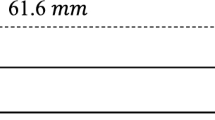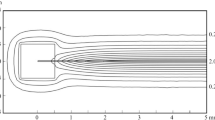Abstract
The purpose of this work is to evaluate the capacity of the heat loss from the carotid artery in the human neck and thus, to provide indirect evidence of the existence of selective brain cooling in humans during hyperthermia. A theoretical model is developed to describe the effects of blood flow rate and vascular geometry on the thermal equilibration in the carotid artery based on the blood flow and the anatomical vascular geometry in the human neck. The potential for cooling of blood in the carotid artery on its way to the brain by heat exchange with the jugular vein and by radial heat conduction loss to the cool neck surface is evaluated. It is shown that the cooling of the arterial blood can be as much as 1.1°C lower than the body core temperature, which is in agreement with previous experimental measurements of the difference between the tympanic and body core temperatures. The model also evaluates the relative contributions of countercurrent heat exchange and radial heat conduction to selective brain cooling. It is found that these mechanisms are comparable with each other. Results of the present study will help provide a better understanding of the thermoregulation during hyperthermia. © 2000 Biomedical Engineering Society.
PAC00: 8719Pp, 8710+e, 8719La, 8719Uv
Similar content being viewed by others
References
Baker, M. A., Brain cooling in endotherms in heat and exercise. Annu. Rev. Physiol.44:85-96, 1982.
Balasubramaniam, T. A., and H. F. Bowman. Thermal conductivity and thermal diffusivity of biomaterials: A simultaneous measurement technique. ASME J. Biomech. Eng.99:148-154, 1977.
Brengelmann, G. L.Specialized brain cooling in humans?FASEB J.7:1149-1153, 1993.
Brengelmann, G. L., M. V. Savage, and D. H. Avery. Reproducibility of core temperature threshold for sweating onset in humans. J. Appl. Physiol.77:1671-1677, 1994.
Cabanac, M., Keeping a cool head. News Physiol. Sci.1:41-44, 1986.
Cabanac, M., Selective brain cooling in humans: "Fancy" or "fact?," FASEB J.7:1143-1147, 1993.
Cabanac, M., and M. White. Heat loss from the upper airways and selective brain cooling in human. Ann. (N.Y.) Acad. Sci.813:613-615, 1997.
Chato, J. C. Selected thermophysical properties of biological materials. In: Heat Transfer in Biology and Medicine, edited by A. Shitzer and R. C. Eberhart. Plenum, New York, 1985, pp. 413–418.
Deklunder, G., M. Dauzat, J. Lecroart, J. Hauser, and Y. Houdas. Influence of ventilation of the face on thermoregulation in man during hyper-and hypothermia. Eur. J. Appl. Physiol.62:342-348, 1991.
Dietrich, W. D.The importance of brain temperature in cerebral injury. J. Neurotrauma9:S475-S485, 1992.
Hirashita, M., O. Shido, and M. Tanabe. Blood flow through the ophthalmic veins during exercise in humans. Eur. J. Appl. Physiol.64:92-97, 1992.
Johnsen, H. K., B. S. Blix, J. B. Mercer, and K. D. Bolz. Selective cooling of the brain in reindeer. Am. J. Physiol.253:R848-R853, 1987.
Mariak, Z., J. Lewko, J. Luczaj, and B. Polocki. The relationship between directly measured human cerebral and tympanic temperatures during changes in brain temperature. Eur. J. Appl. Physiol.69:545-549, 1994.
McCaffrey, T. V., R. D. McCook, and R. D. Wurster. Effect of head skin temperature on tympanic and oral temperature in man. J. Appl. Physiol.39:114-118, 1975.
Nielsen, B.Natural cooling of the brain during outdoor bicycling?Pflugers Arch. Ges. Physiol. Menschen Tiere411:456-461, 1988.
Nielsen, B., and C. Jessen. Evidence against brain stem cooling by face fanning in severely hyperthermic humans.Pflugers Arch. Ges. Physiol. Menschen422:168-172, 1992.
Nishita, M.Cerebrovascular diseases and tympanic temperature (in Japanese). J. Aichi. Med. Univ. Assoc.20:721-729, 1992.
Nunneley, S. A., and D. A. Nelson. Limitations on arteriovenous cooling of the blood supply to the human brain. Eur. J. Appl. Physiol.69:474-479, 1994.
Rasch, W., and M. Cabanac. Selective brain cooling is affected by wearing headgear during exercise. J. Appl. Physiol.74:1229-1233, 1993.
Rubenstein, E., D. W. Meub, and F. Eldridge. Common carotid blood temperature. J. Appl. Physiol.15:603-614, 1960.
Valvano, J. W., J. T. Allen, and H. F. Bowman. The simultaneous measurement of thermal conductivity, thermal diffusivity, and perfusion in small volumes of tissue. ASME J. Biomech. Eng.106:192-197, 1984.
Wang Z., X. G. Liang, Y. P. Zhang, X. S. Ge, and S. X. Cheng. Theoretical and experimental research on determining the thermophysical properties and calorific intensity of the organ or tissue of living body with a thin hot-probe. Proceedings of the 3rd Asian Thermophysical Properties Conference (Beijing), edited by B. X. Wang. 1992, pp. 647–653.
Weinbaum, S., L. X. Xu, L. Zhu, and A. Ekpene. A new fundamental bioheat equation for muscle tissue: Part I—blood perfusion term. ASME J. Biomech. Eng.119:278-288, 1997.
Wenger, C. B. More comments on "keeping a cool head." News Physiol. Sci.2:150-151, 1987.
Wu, Y., S. Weinbaum, and L. M. Jiji. A new analytic technique for 3-d heat transfer from a cylinder with two or more axially interacting eccentrically embedded vessels with application to countercurrent blood flow. Int. J. Heat Mass Transf.36:1073-1083, 1993.
Zenker, W., and S. Kubik. Brain cooling in humans—Anatomical considerations. Anat. Embryol.193:1-13, 1996.
Zhu, L., and S. Weinbaum. A model for heat transfer from embedded blood vessels in 2-d tissue preparation. ASME J. Biomech. Eng.117:64-73, 1995.
Rights and permissions
About this article
Cite this article
Zhu, L. Theoretical Evaluation of Contributions of Heat Conduction and Countercurrent Heat Exchange in Selective Brain Cooling in Humans. Annals of Biomedical Engineering 28, 269–277 (2000). https://doi.org/10.1114/1.266
Issue Date:
DOI: https://doi.org/10.1114/1.266




